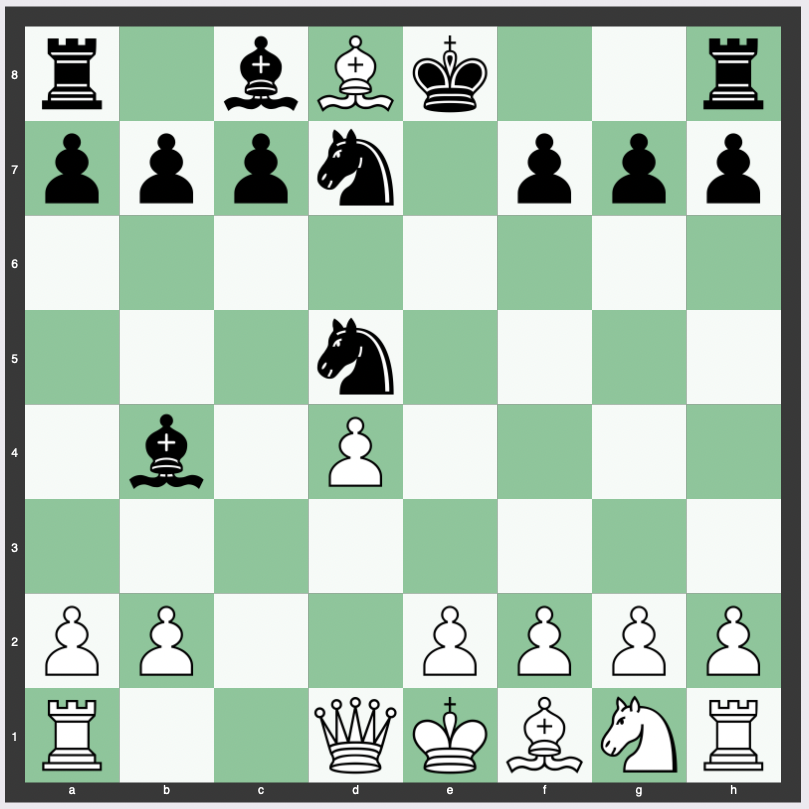The Elephant Trap in chess is an intriguing and deceptive opening sequence that has fascinated players for over a century.
Known as a faulty attempt by White to win a pawn in the popular Queen’s Gambit Declined, the trap presents multiple layers of complexity that attract both novice and seasoned players.
This article will explore the move order, theory, strategy, and purpose behind the Elephant Trap, its variations, historical significance, its appropriateness for different levels of players, and its prevalence at the Grandmaster level.
Move Order of the Elephant Trap
The Elephant Trap is characterized by the following sequence of moves:
- d4 d5 2. c4 e6 3. Nc3 Nf6 4. Bg5 Nbd7
From this position, White may fall into the trap by attempting to capture a pawn, leading to:
- cxd5 exd5 6. Nxd5?? (first diagram below) 6… Nxd5! 7. Bxd8 Bb4+ (second diagram below) 8. Qd2 Bxd2+ 9. Kxd2 Kxd8 (third diagram below)

After 7. Bxd8 Bb4+

This sequence leaves Black a minor piece ahead, illustrating the perilous nature of the trap.

Theory, Strategy and Purpose of the Elephant Trap
The Elephant Trap is based on a psychological ploy where Black sets a trap by tempting White into capturing a seemingly free pawn.
The strategy focuses on the false assumption that the black knight on f6 is pinned to the queen and cannot move.
This leads White to think that capturing the pawn on d5 is safe, only to fall into Black’s cleverly laid snare.
Variations of the Elephant Trap
While the aforementioned sequence is the classic illustration of the Elephant Trap, there are different variations and possible continuations based on both players’ decisions.
The initial opening sequence often leads to either the Cambridge Springs Defense or the Orthodox Defense, depending on Black’s subsequent moves.
Both these options add further depth and tactical possibilities to the game.
History of the Elephant Trap
The earliest recorded occurrence of the Elephant Trap is found in the game between Karl Mayet and Daniel Harrwitz, played in Berlin in 1848.
This game not only solidified the Elephant Trap as a recognized tactical theme but also contributed to the evolving chess culture during the 19th century.
Win a piece in 9 moves (Elephant Trap)
Is the Elephant Trap Good for Beginners or Intermediates?
The Elephant Trap is suitable for both beginner and intermediate players.
For beginners, it serves as a valuable lesson in tactics and understanding chess principles such as pins and threats.
Intermediate players can use the Elephant Trap as a springboard to explore more complex strategies, including the variations stemming from it.
How Often Is the Elephant Trap Played at the Grandmaster Level?
While the Elephant Trap is a fascinating tactic, it is very rarely seen at the Grandmaster level due to its well-known nature.
Most experienced players are familiar with this trap and can easily avoid falling into it.
As a result, it tends to be more commonly employed in amateur or less formal games.
5 Queen’s Gambit Traps Every Chess Player Should Know
Conclusion
The Elephant Trap is a fascinating aspect of chess that continues to engage players of all skill levels.
From its intriguing move order to the underlying theory and strategy, it presents a tactical richness that resonates with the essence of the game.
Its historical significance and adaptability for players ranging from beginners to intermediates add to its appeal.
However, its rarity at the Grandmaster level demonstrates the importance of continual learning and adaptation in the ever-evolving game of chess.
Whether a curiosity or a serious part of one’s chess repertoire, the Elephant Trap symbolizes the depth, subtlety, and complexity that make chess an enduring intellectual pursuit.
Related


